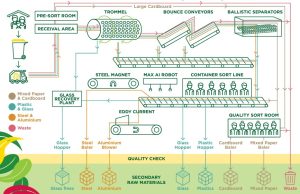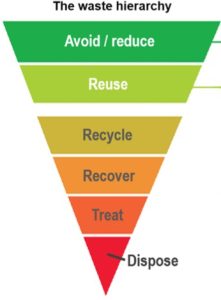“Wish-cycling” is where we put things in the recycling bin, in the hopes that it can be recycled, without finding out whether that item is really recyclable. We feel like we’ve done the right thing and now it’s someone else’s problem, right? Yeah, we’ve all done it. Many products are physically recyclable, and the labels on the packaging tell us that it’s recyclable material, but the facilities are not available here in SA or there is no market for the end product. If you’re not sure whether something is recyclable, don’t put it in the yellow bin and potentially contaminate a whole truckload, visit Which Bin SA (or your local council website) to find out.
As part of our ongoing professional development, our team recently visited the facilities at NAWMA (Northern Adelaide Waste Management Authority) for a tour and presentation about the material recovery process. The NAWMA material recovery facility was opened in 2017 and is owned and operated by City of Salisbury, City of Playford and Town of Gawler local councils. It accepts kerbside collections from over 110,000 households across the north of Adelaide, as well as commercial collections.
Poor waste management can have a financial cost on a business. Collections are usually charged per pick up so excess waste collections can significantly impact your bottom line. Indirectly, it has been found that businesses which demonstrate a commitment to reducing their environmental impact often enjoy an edge over their competitors and helps staff feel like they work for a responsible employer. Creating change, by setting up more efficient waste management systems and educating staff, can be an investment in your reputation and your business. You can inspire loyalty by demonstrating to customers and staff that you are innovative and future proofing . If you don’t have time to manage this process yourself, we can help with auditing, training and monitoring systems.
Sadly, up to 40% of the mixed recycling that arrives at the NAWMA facility is contaminated and ends up going to landfill. This highlights the importance of efficient waste sorting at home and in the workplace. The more we can help by sorting our waste into the correct waste streams, the better the chance of it actually getting recycled instead of ending up in landfill. This figure is consistent with the latest National Waste Report which stated the national resource recovery rate at 63%. However, here in SA we have the highest recovery rate at 80% which is amazing. Well done, South Australians!
It’s important to note that NAWMA is a sorting facility. They don’t do any recycling on site. Waste materials are collected, and hand sorted (by real humans) before the material is shipped to whoever can do the recycling. An exciting innovation at NAWMA is their glass recovery plant which filters the smaller pieces of broken glass that the human sorters can’t pick up with their safety gloves on. These small pieces of glass are crushed and used for making new bottles, or as a sand replacement for road surfaces. Glass wastage is minimal.

A diagram of the waste flow at the material recovery facility
 The highest value recyclable products are PET and HDPE plastics, and steel cans, which yield a high amount of recyclable material and can be sold for reuse or repurposing. There is no point collecting recyclable material if there isn’t an end use for the product. This is the problem we had with the now defunct REDcycle scheme. As soon as there was no market for the soft plastics that were being collected at supermarkets, there was no longer any point in recovering them and it now goes to landfill. The best bet for this type of packaging is to start at the top of the waste hierarchy and avoid or refuse soft plastics in the first place. Look for items sold in bulk and use compostable bags for your vegies. Contact the manufacturers of your favourite products and ask them about their end-of-product-life policy. We need to push back on manufacturers to provide more sustainable packaging and product disposal options.
The highest value recyclable products are PET and HDPE plastics, and steel cans, which yield a high amount of recyclable material and can be sold for reuse or repurposing. There is no point collecting recyclable material if there isn’t an end use for the product. This is the problem we had with the now defunct REDcycle scheme. As soon as there was no market for the soft plastics that were being collected at supermarkets, there was no longer any point in recovering them and it now goes to landfill. The best bet for this type of packaging is to start at the top of the waste hierarchy and avoid or refuse soft plastics in the first place. Look for items sold in bulk and use compostable bags for your vegies. Contact the manufacturers of your favourite products and ask them about their end-of-product-life policy. We need to push back on manufacturers to provide more sustainable packaging and product disposal options.
Additionally, we need to consider the importance of buying products made from recycled materials to “close the loop” on the circular economy. If there is no market for recycled materials, there is no incentive for organisations like NAWMA to collect that material. So, when you are shopping, or if you have any say in the procurement policies at your workplace, consider buying products made from recycled materials to ensure that there is a market for the waste we are sending away for recycling. And if you are able, visit your local resource recovery centre and take a tour. They’re doing good things, and it might surprise and inspire you.

